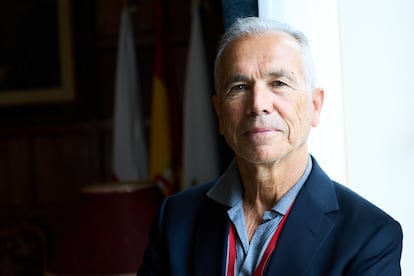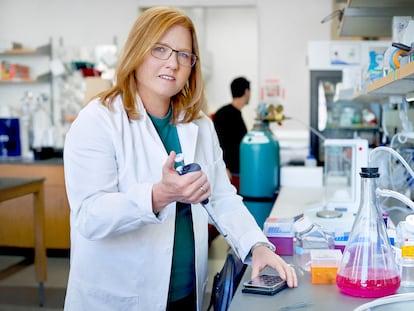‘Without the kissing disease virus, your risk of multiple sclerosis is practically zero’
Alberto Ascherio, professor of epidemiology at Harvard University, has discovered the main cause of one of the most enigmatic diseases


This year, Italian epidemiologist Alberto Ascherio solved one of the great mysteries of medicine. In January, his team proved that the Epstein-Barr virus, which causes mononucleosis (also known as the kissing disease), is also the main cause of multiple sclerosis, an enigmatic disorder in which the protective covering of neurons is destroyed. In some cases, the patients – usually diagnosed in their twenties or thirties – can deteriorate to the point of struggling to talk and walk. Until now, the three million people living with multiple sclerosis worldwide did not know what the real trigger of their disease was.
In 2000, Ascherio’s team, from Harvard University, began to rigorously monitor 10 million US soldiers. Their results show that the risk of multiple sclerosis increases by 32 times after being infected by the kissing disease virus. In an interview, Ascherio explains how a virus as omnipresent as the Epstein-Barr, which infects 94% of the population, is to blame for a disease as rare as multiple sclerosis, with just 36 cases per 100,000 people.
Question. If you are not infected with the Epstein-Barr virus, what is your risk of having multiple sclerosis?
Answer. Practically zero. Multiple sclerosis probably doesn’t develop if a person is not infected with the virus.
Q. You have stated that the virus is “the main cause” of multiple sclerosis. Virologist Jeffrey Cohen, from the US National Institutes of Health, has declared that he prefers to be cautious with the word “cause,” and talks about a “necessary precondition.” What are your thoughts on this?
A. I don’t think that way, to tell the truth. It’s a bit of a paradox, because calling it a necessary factor implies that it is a causal factor in 100% of the cases. When I say that it is a cause, I say that it is the causal factor of 99.9%, a little less.
Q. So you do believe that the Epstein-Barr virus causes multiple sclerosis.
A. Yes, I think that there is no doubt that multiple sclerosis is a rare complication of an Epstein-Barr virus infection, but there are always other factors. How is it possible for such a common virus to cause such a rare disease? Well, this is not an exception; it’s the rule. The Epstein-Barr virus causes Burkitt’s lymphoma, which is a rare lymphoma, and it also causes nasopharyngeal carcinoma, which is also very rare. Many viruses cause serious illnesses occasionally.
Q. For example?
A. Before there was a vaccine, practically all children used to be infected by the polio virus. And one in 400 children had paralytic polio, but the other 399 didn’t. There is always a genetic predisposition, environmental factors, other infections or a set of factors. It is the same thing that happens with Covid-19: some people die while others have no symptoms.
Q. Could there be another cause of multiple sclerosis, besides the Epstein-Barr virus? Is there another candidate?
A. No. We looked into all known viruses for our study, and no other emerged as a possible candidate. In multiple sclerosis, the virus triggers a complex inflammatory autoimmune process. In very rare situations, this could happen without a known cause; we can’t exclude the option of another virus. But those would be very rare cases.
Q. Almost everyone has the Epstein-Barr virus in their saliva.
A. Yes. It reactivates periodically. If we stop people on the street and test them, 20% will test positive. But you can also test negative now and test positive in two weeks. Virus excretion is intermittent.
Q. The Epstein-Barr virus is like other members of the herpesvirus family: it can integrate its DNA into your own DNA, inside human cells.
A. It can integrate into human DNA, but in most people, the DNA of the virus remains in a tiny pellet inside the human cell. It connects to human DNA when the cell reproduces. As the human cell divides in two, the virus also reproduces.
Q. Is it then possible to envision a treatment that eliminates the virus from our cells?
A. Theoretically, yes. We can block the replication of the virus when the cell reproduces.
Q. Do you think that a person with multiple sclerosis could be cured if the virus is removed?
A. That is still unknown. We proved that the virus causes the disease, but there are two aspects: it can cause just the onset of the disease, or it can also cause its progression. It is almost certain that if the virus is present it will continue to stimulate this autoimmune response. It is likely, but not certain. It is also possible that, even if the virus is removed, this immune process will continue on its own. We still don’t know the answer.
Q. It would be amazing if it worked.
A. It would be amazing, and I think it’s something that should be studied. The only way to know, in my opinion, is to try antiviral treatments. There are some ongoing studies, like a trial that is being carried out with immune cells that kill the virus, cytotoxic T cells specific for the Epstein-Barr virus. We ourselves tried to carry out some studies with an antiviral that is effective against the virus, but we don’t have a magic bullet, a drug that kills the virus for good. There are drugs with intermediate activity which reduce proliferation, but we don’t know if it will be enough.
Q. Have your latest results driven research into the disease?
A. Yes, I think, a lot, at all levels and, especially, regarding the vaccines, because that would be the most logical way to act. If multiple sclerosis is caused by a very aggressive immune response against the virus, then a vaccine would be able to modulate that response so that it is less aggressive. Currently, the American company Moderna has an experimental vaccine against the Epstein-Barr virus.
Q. Do we have a clear understanding of the way the virus behaves in a person with multiple sclerosis?
A. Not really, we still don’t quite get it. There was a series of investigations in 2007 that showed that multiple sclerosis lesions have cells infected with the virus, that the virus reactivates, that the immune system attacks those cells and it causes all the inflammation around it, damaging the myelin (the sheath of neurons). The results seemed very conclusive, but afterwards, other laboratories were unable to replicate them. And others, more recently, have. They are difficult studies, on which they are working with autopsy material from people who died of multiple sclerosis. It’s a disease that lasts for decades, so we’re trying to understand how the inflammatory process started by looking 10 years later. It’s not easy.
Q. What other viruses are involved in the development of autoimmune diseases?
A. The truth is that there is no very clear evidence. The Epstein-Barr virus itself is probably associated with an increased risk of systemic lupus erythematosus, but most autoimmune diseases are considered to be of unknown cause. Infections likely play a role, but this hasn’t been clearly proved.
Q. Smokers have twice the risk of contracting multiple sclerosis than non-smokers. Why?
A. The mechanisms are unclear. Lung inflammation could possibly have some interaction with the Epstein-Barr virus.
Q. What about other risk factors for multiple sclerosis, such as childhood obesity?
A. Of the factors that can be corrected, probably the most important one is vitamin D deficiency. The second would be smoking. Childhood obesity is associated with vitamin D deficiency. Some people think that there is an effect of obesity that’s independent of the effect of vitamin D, but I’m not 100% sure.
Q. In your laboratory, you also study the role of drugs, diet and lifestyle in the risk of Parkinson’s disease. Have you reached any conclusion?
A. Regarding Parkinson’s, the main conclusion is that physical activity has a protective effect. As for diet, we have interesting results, but the level of certainty is not as strong. The Mediterranean diet and the flavonoids, which are antioxidant components, are associated with a reduced risk of Parkinson’s. Proving causality is complicated. We are studying the initial phase of Parkinson’s, and we see that the Mediterranean diet is associated with a lower frequency of the first symptoms. We don’t mean that 90% of cases can be prevented with the Mediterranean diet; we are talking about preventing 10% to 15%. It is promising, because it’s the best thing we have after physical activity, but we are not going to get rid of Parkinson’s with diet. However, we can get rid of multiple sclerosis with a vaccine.
Q. What is the main hypothesis about the cause of Parkinson’s?
A. There are risk factors, such as the exposure to pesticides. I think it almost certainly increases the risk of Parkinson’s, but we’re talking about doubling the risk. The vast majority of people with Parkinson’s don’t have substantial exposure to pesticides. I think the causes are quite complex, with many contributing factors. There are 10% or 15% of cases that have genetic mutations. In the rest of the cases, it is not known.
Q. Men have a 1.5 times higher risk of having Parkinson’s than women. What could be the reason?
A. Yes, it is more common in men, and we also don’t know why. Differences in disease risk between men and women are common. Multiple sclerosis is more common in women. In most cases, it is not known. Some talk of hormones, of course, but in reality there is not a clear understanding.
Tu suscripción se está usando en otro dispositivo
¿Quieres añadir otro usuario a tu suscripción?
Si continúas leyendo en este dispositivo, no se podrá leer en el otro.
FlechaTu suscripción se está usando en otro dispositivo y solo puedes acceder a EL PAÍS desde un dispositivo a la vez.
Si quieres compartir tu cuenta, cambia tu suscripción a la modalidad Premium, así podrás añadir otro usuario. Cada uno accederá con su propia cuenta de email, lo que os permitirá personalizar vuestra experiencia en EL PAÍS.
¿Tienes una suscripción de empresa? Accede aquí para contratar más cuentas.
En el caso de no saber quién está usando tu cuenta, te recomendamos cambiar tu contraseña aquí.
Si decides continuar compartiendo tu cuenta, este mensaje se mostrará en tu dispositivo y en el de la otra persona que está usando tu cuenta de forma indefinida, afectando a tu experiencia de lectura. Puedes consultar aquí los términos y condiciones de la suscripción digital.










































